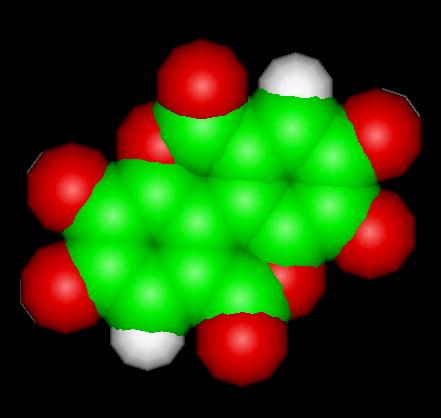Ellagic Acid Molecule

Trans Fatty Acid Molecule -- Elaidic Acid-- Space Fill Model
To View the Ellagic d Molecule in 3D using Jsmol
From:
p53/p21(WAF1/CIP1) expression and its possible role in G1 arrest and apoptosis in ellagic acid treated cancer cells.
Narayanan BA, Geoffroy O, Willingham MC, Re GG, Nixon DW. Cancer Lett. 1999 Mar 1;136(2):215-21.
Ellagic acid is a phenolic compound present in fruits and nuts including raspberries, strawberries and walnuts. It is known to inhibit certain carcinogen-induced cancers and may have other chemopreventive properties. The effects of ellagic acid on cell cycle events and apoptosis were studied in cervical carcinoma (CaSki) cells. We found that ellagic acid at a concentration of 10(-5) M induced G arrest within 48 h, inhibited overall cell growth and induced apoptosis in CaSki cells after 72 h of treatment. Activation of the cdk inhibitory protein p21 by ellagic acid suggests a role for ellagic acid in cell cycle regulation of cancer cells.
From:
Combined inhibition of PDGF and VEGF receptors by ellagic acid, a dietary-derived phenolic compound.
Carcinogenesis. 2005 Apr;26(4):821-826. Epub 2005 Jan 20.
Labrecque L, Lamy S, Chapus A, Mihoubi S, Durocher Y, Cass B, Bojanowski MW, Gingras D, Beliveau R.
The vascular endothelial growth factor (VEGF) and platelet-derived growth factor (PDGF) receptors play essential and complementary roles in angiogenesis and combined inhibition of these receptors has been shown to result in potent antitumor activity in vivo. In this study, we report that ellagic acid (EA), a natural polyphenol found in fruits and nuts, inhibits VEGF-induced phosphorylation of VEGFR-2 in endothelial cell (EC) as well as PDGF-induced phosphorylation of PDGFR in smooth muscle cells, leading to the inhibition of downstream signaling triggered by these receptors. EA also specifically inhibited VEGF-induced migration of ECs as well as their differentiation into capillary-like tubular structures and abolished PDGF-dependent smooth muscle cell migration. Interestingly, EA presents a greater selectivity for normal cells than for tumor cells since the migration of the U87 and HT1080 cell lines were much less affected by this molecule. The identification of EA as a naturally occurring dual inhibitor of VEGF and PDGF receptors suggests that this molecule possesses important antiangiogenic properties that may be helpful for the prevention and treatment of cancer.